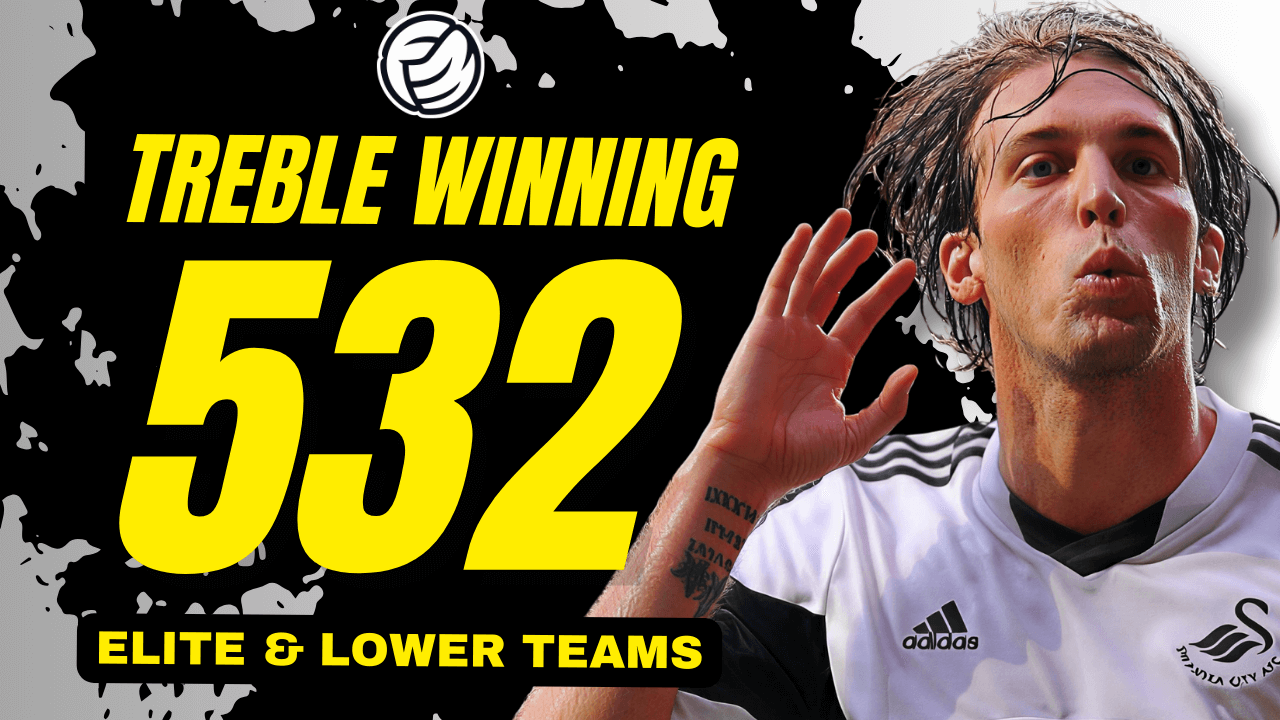
Also made upgrades to ball physics and matchday lighting to level up the immersion.
 |
Pre-purchase FM24 from FM ScoutStart playing 2 weeks earlier with early beta access, and get a verified buyer badge for your FM Scout account! |
Positional Play
Positional play is an approach that sees players take up positions on the pitch that help their side to create numerical advantages with passing triangles and diamonds.The intention of these shapes is to create space, give the ball-carrier several passing options and allow the team to progress possession up the pitch towards the final third.
Positional play is one of world football’s most popular principles nowadays and emulation attempts of that approach in FM have become a thing.
In FM24 we get more tools to help us nail that replication, particularly with regards to improving player rotations on the pitch.
Rotation Changes
Some players, based on their role and those you’ve included around them, can now move into another position while you’re in possession than would be expected from their default starting base.For example, say you have a 4-2-3-1 with two defensive midfielders where your pivot players are a Segundo Volante and a defensive Ball-Winning Midfielder and the player just behind the striker is an Advanced Playmaker.
The Advanced Playmaker now recognises the attacking runs of the Segundo Volante in behind.
This means that the Advanced Playmaker will move across to open a new channel, freeing up the Segundo Volante to push up as a second number 10 and effectively create a 4-1-4-1 shape in attack.
To accommodate this movement, your Ball-Winning Midfielder would occupy a more central position to provide more effective cover.
These rotations work with other aggressive defensive and central midfield roles too, like Roaming Playmakers and Mezzalas.
The behaviour of the Inverted Winger and Inside Forward roles has been tweaked.
When they recognise that you’ve got an additional midfield player pushing up into the half space on their side, they will stay wider to accommodate them and help you create more overloads.
The Half-Back role has had some alterations for FM24. Now, depending on where you’re using them in a double pivot, it can take up either the left or right centre-back position while you’re in possession.
Your players should have more passing lanes open to them and a better ability to play through the lines, allowing your team’s shape to dynamically adjust between different phases of attack.
New Player Role: Inverted Full-Back
There's a brand-new player role in FM24; the Inverted Full-Back (IFB).This new role functions as a traditional Full-Back when defending but in possession transitions to become a third central defender.

When the Inverted Full-Back combines with your other central defenders to make a back three, the outermost two function like Wide Centre-Backs.
This means that the defender on the side of the pitch where the ball is, can move slightly further forward to support the play.
This IFB role enables you to experiment with three-at-the-back building shapes while defending in a back four, something that many of the world’s top teams are currently doing.
It also frees up someone else in your backline to move up into midfield.
Levelled Up Inverted Wing-Back
The IWB is another role with much more intelligent and responsive positioning in FM24.Now, the defensive midfielders are more suited to recognising the movement of the Inverted Wing-Back. This means that when an Inverted Wing-Back pushes up, a deeper-lying defensive midfielder on their side will move across to form a two-man pairing.
This adaptation is very similar to the way Rodri tends to dovetail with the full-back on his side of the pitch at Manchester City.
Enhanced Libero
The 'John Stones' role - a centre-back stepping up into midfield - is included in FM24 thanks to significant improvements made to the way the Libero functions.Available now in both a back four and all three central defensive roles in a back three, the Libero will move up into defensive midfield in a similar way to the Inverted Wing-Back.
In addition to the midfielders adjusting their position to accommodate the Libero’s forward movement, your central defenders will suitably adapt to the Libero stepping out of the defensive line.
As such, your central defenders will now alter their behaviour depending on the number of active players in your backline. If there are two, they will function as a traditional centre-back pairing but split further across the pitch to cover space more effectively.
If you play an Inverted Wing-Back and a Libero on the same side of the defensive line, the Libero will not push up. This is because the Inverted Wing-Back has priority when both roles are being asked to transition into the same space.
These changes to the Libero, as well as to the other roles outlined above, ultimately mean that there’ll be greater fluidity and dynamism to your tactics and the way they perform on Matchday.
Better Player Motion
Outside of their role behaviour, players now appear more intelligent when they’re moving into positions.This is thanks to data that greatly improves the authenticity and fluidity of the animations beyond traditional studio-based motion capture.
Also improved the animation engine, utilising the Inverse Kinematics system to reflect the real-life captured data in the most accurate and realistic way possible.
To make use of the new database of animations, there's a new system called Motion Matching which makes it possible to identify these more realistic animations and directly use them for every player in FM relative to the context of the match.
Motion Matching, in combination with Inverse Kinematics, will bring a lot more fluidity to player movements.
These animation changes are mostly noticeable with off-the-ball actions like running, pointing and defensive jockeying.
Players will now position themselves on the half-turn much more often, meaning that they can receive the ball and turn more easily, again allowing you to play through the opposition more than ever before.
Ball Physics Rewritten
The ball physics system has been rewritten to be more accurate to real life.The engine now models drag and air resistance more effectively, meaning that the ball will float and spin more authentically. Similarly, deflections will also appear more realistically.
Weather is another factor that will affect the movement of the ball, as will things like the temperature or the altitude of the stadium that you’re playing at.
The way players dribble and finish has also been enhanced.
Implemented more authentic ball friction with the ground, meaning that dribbling attempts will be more realistically affected by the pitch and the weather conditions.
Players are now less likely to dribble all the way to the byline before stopping and turning around. Instead, they’ll slow down earlier to face up the opposition defender.
These changes also mean that players are now able to volley the ball into the ground and are more likely to connect with downward headers when the right situation arises.
Improved Lighting and Pitch Textures
Lighting and pitch textures have been significantly enhanced.
 |
 |
Day, night and interior lighting have all been upgraded to ensure that you get better colour grading based on the weather, season and time of day.
Also updated fog settings, so that the time of day and weather conditions are more obvious in every match.
Pitch textures now have a much sharper and more natural look and feel to them.
Upgrades to lighting, pitch textures and environments visually enhance your matchday experience, making it the best one yet.
Information Source: footballmanager.com

Pre-purchase FM24 from fmscout.com to enjoy early access to the Beta version by mid-late October, a chance to win a key of Genie Scout 24g, a unique buyer badge on our site, and our gratitude for supporting our community financially.









![[FM26] Leagues Mega Pack by @Timo@ (204 Nations + 24 Feminines + 7 Others)](assets/downloads/fm26/fm26-leagues-pack-by-timo.th.png)

Discussion: FM24 Match Engine Upgrades
No comments have been posted yet..